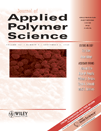Compositional differences of propylene–ethylene block copolymers manufactured by degradation and hydrogenation techniques
Abstract
The purpose of the present work is to investigate the compositional difference of polypropylene–polyethylene block copolymers (PP-b-PE) manufactured industrially by the process of degradation and hydrogenation, respectively. Each of the PP-b-PE copolymers was fractionated into three fractions with heptane and chloroform. The compositions of the three fractions were characterized by 13C nuclear magnetic resonance (NMR) and Fourier transform infrared (FTIR) spectroscopy, as well as differential scanning calorimetry (DSC) and thermal fractionation. The results showed that the Chloroform-soluble fraction was amorphous ethylene-propylene rubber, and the content of the rubber in PP-b-PE manufactured by hydrogenation was less than that by degradation. The degree of crystallinity of the chloroform-insoluble fraction of the PP-b-PE manufactured by hydrogenation is higher than that of by degradation. © 2006 Wiley Periodicals, Inc. J Appl Polym Sci 101: 3301–3306, 2006




